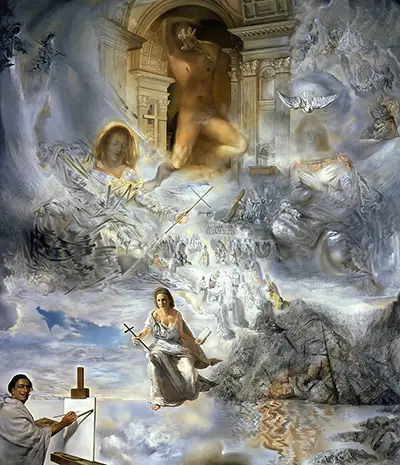It is executed on a large canvas measuring over 9 feet tall. The picture is on display in the Salvador Dalí Museum in St. Petersburg, Florida, USA.
The picture uses a blend of Surrealist, modern and classical techniques to illuminate a Christian religious theme in an ultra-modern form. As in Velazquez's painting Las Meninas, which Dali knew and loved, the artist himself appears in the bottom left-hand corner of the painting, staring out at the viewer as he holds his paintbrush to a blank canvas, about to paint the scene of which he is a part.
Above him floats a stormy scene of hyper-religious Baroque chaos. The classical forms of a traditional Catholic painting are there but they have been stirred up as if in a blender. It looks as if the figures and the sky are about to explode out of the painting.
Dali began work on the picture in 1958 upon the election of Pope Johm XXIII, as the pope was preparing to enter into dialogue with the then Archbishop of Canterbury - hence the title reference to an Ecumenical Council.
The picture reflects this with an unorthodox image of the Holy Trinity supervising the coronation of the new pope. The violent movement and contortion of the figures is reminiscent of Baroque and Counter-Reformation art.
God the Father appears in a neo-Classical niche, obscuring his face and without genitals. A figure of Christ holds out a rectilinear cross, while on the right an image of the Holy Spirit in the form of a dove descends on a cloudy figure of the Virgin Mary.
The figure and the dove together may represent the Holy Spirit, and reference the Annunciation. The ambiguity in the identity of the three persons of the Trinity may be deliberate and the lower two figures are androgynous: they could be either male of female.
Below the figure of the Trinity, Dali's wife and muse Gaia appears in the guise of St Helena, the mother of Constantine, who was believed to have found the True Cross. Like the figure of Christ, Gaia holds out a cross.
The cliff formation realistically depicted below as the movement of the picture descends towards the figure of the painter is the Cap de Creuz. The picture is highly referential and stuffed with theological and personal tropes.
Dali has painted himself and Gaia into a historical (in time) but also religious (out of time) work. This echoes not only the work of Velazquez but that of mediaeval and renaissance artists who often showed donors or patrons in close personal contemplation of divine or saintly figures, within the same space.


